People in the knife and survivalist communities often talk about how, in the right hands, a small knife can complete many of the tasks typically intended for larger blades, but is the same true for big survival knives?
I decided to test just how detailed the SLYSTEEL Survival Kukri knife could get when crafting a try stick to answer this question. I reasoned that if this modified Kukri knife could carve some of the more minor features on a try stick, I could rely on it to perform even the smallest survival tasks.
I believe that an essential part of being prepared is knowing what your tools are capable of, so join me in testing the SLYSTEEL Survival Kukri’s small-knife capabilities.
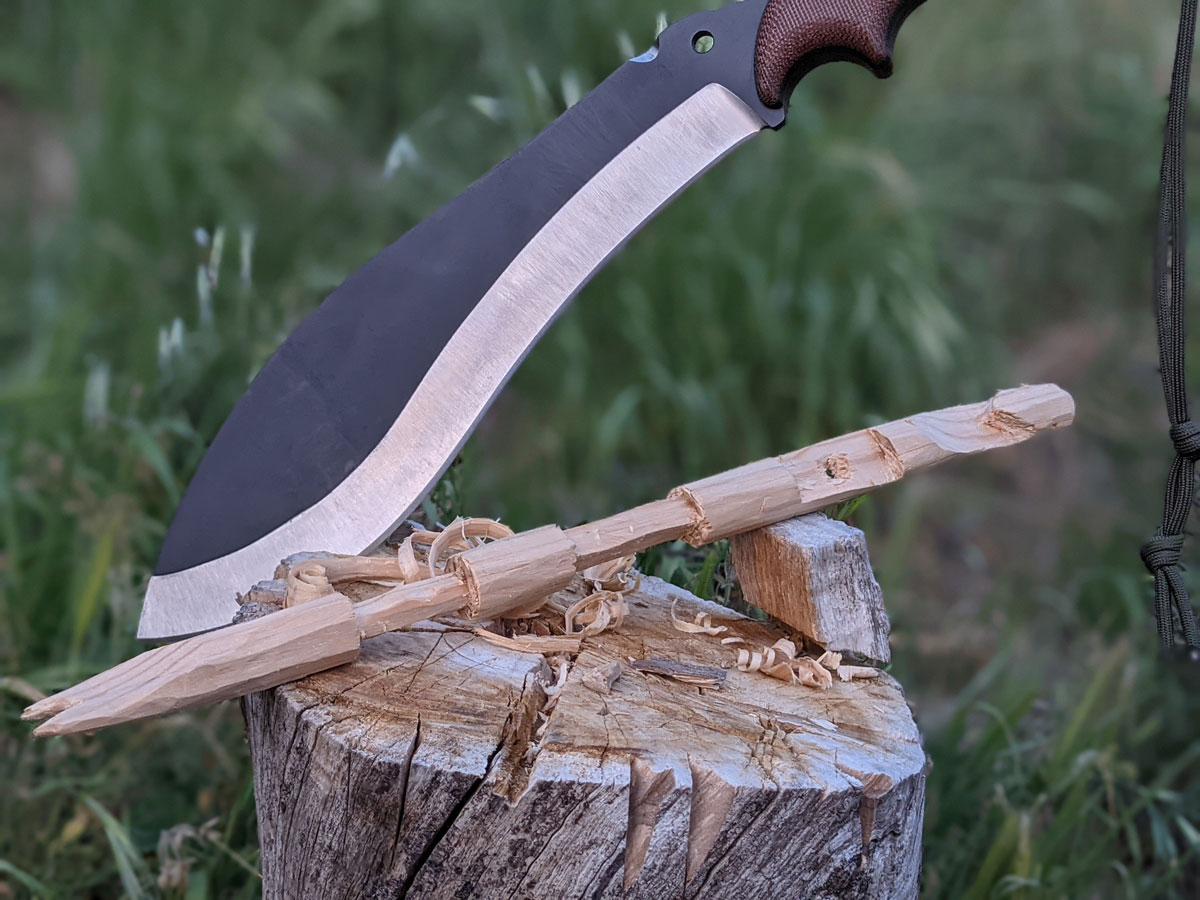
The Importance of Utilizing Multiple Knives
While everybody has their own opinion about how many knives you should bring when entering the backcountry, there is a consensus in the survivalist community that different knives serve different functions. Therefore, to best prepare for any eventuality, you should always be sure to bring multiple knives with you.
Furthermore, if you accidentally misplace or lose one of your knives, you don’t want to get stuck in a situation where you’re miles from civilization with no way to protect yourself, build a shelter, or prepare food.
In everyday life, I carry three knives on my person of various sizes, but when I plan on heading outdoors, I’ll typically add a fixed blade to my knife selection.
By carrying different-sized knives, I can ensure that I can do any task needed, and a large knife like the SLYSTEEL Survival Kukri knife is always a must to handle larger jobs like chopping wood or bushwhacking.
How Big Is a “Big” Survival Knife?
To better inform this discussion and illustrate what the Survival Kukri is capable of, I should clarify what I consider the minimum size of a “big” or “large” survival knife to be.
In this article, any knife that I refer to as being large has a blade size of eight or more inches, as this is about how big a knife needs to be to have the ability to complete tasks like splitting wood.
In contrast, I consider any knife with a blade size of four inches or less to be a small knife, while medium-sized knives have blades between these two lengths.
About the SLYSTEEL Survival Kukri Knife
Kukri knives are popular choices amongst hunters, hikers, and survivalists because of their closeness to a classic machete. These large blades originated in Nepal and are still the country’s national weapon used by the Nepalese army.
I can say from personal experience, however, that after getting my own Nepalese-made Kukri, I’m not sure I would endeavor to carry it on backcountry trips with me, as these knives are hefty and cumbersome to carry around, albeit durable and versatile.
Fortunately, there are many modern interpretations of the Kukri knife, and SLYSTEEL has managed to deliver the same versatility and durability as a traditional Kukri with roughly half the weight and size by opting for a significantly thinner 1095 carbon steel blade.
Knife Specs
Below are the specs of the Survival Kukri:
- Weight: 24 ounces
- Overall Length: 16 inches
- Blade Length: 9 7/8 inches
- Blade Thickness: 3/16 inches
- Blade Steel: 1095 carbon
- Hardness: RC 56-58
- Blade Finish: Black and clear Cerakote
- Handle Material: Tan and black micarta with red liners
- Heat Treatment: Differential; blade edge and spine
- Designers: Oliver and Christopher Hannan
- Made in: Idaho, USA
While this highly versatile blade may seem designed specifically for bigger tasks, the knife utilizes an ergonomic design, giving the user the ability to perform much more detailed tasks.
The Lanyard Loop
The lanyard loop on the Survival Kukri is one of the knife’s most essential features, and utilizing the lanyard gave me significantly more control over the blade when performing both large and small survival tasks.
When using the Kukri knife for tasks like splitting wood, I made sure to have the most secure hold possible by following these three steps:
1. I had the lanyard custom-fitted so that it could fit my entire hand and forearm through the loop opening. I then inserted my thumb through the end of the loop opposite the handle, with the palm of my hand facing up, as seen below:
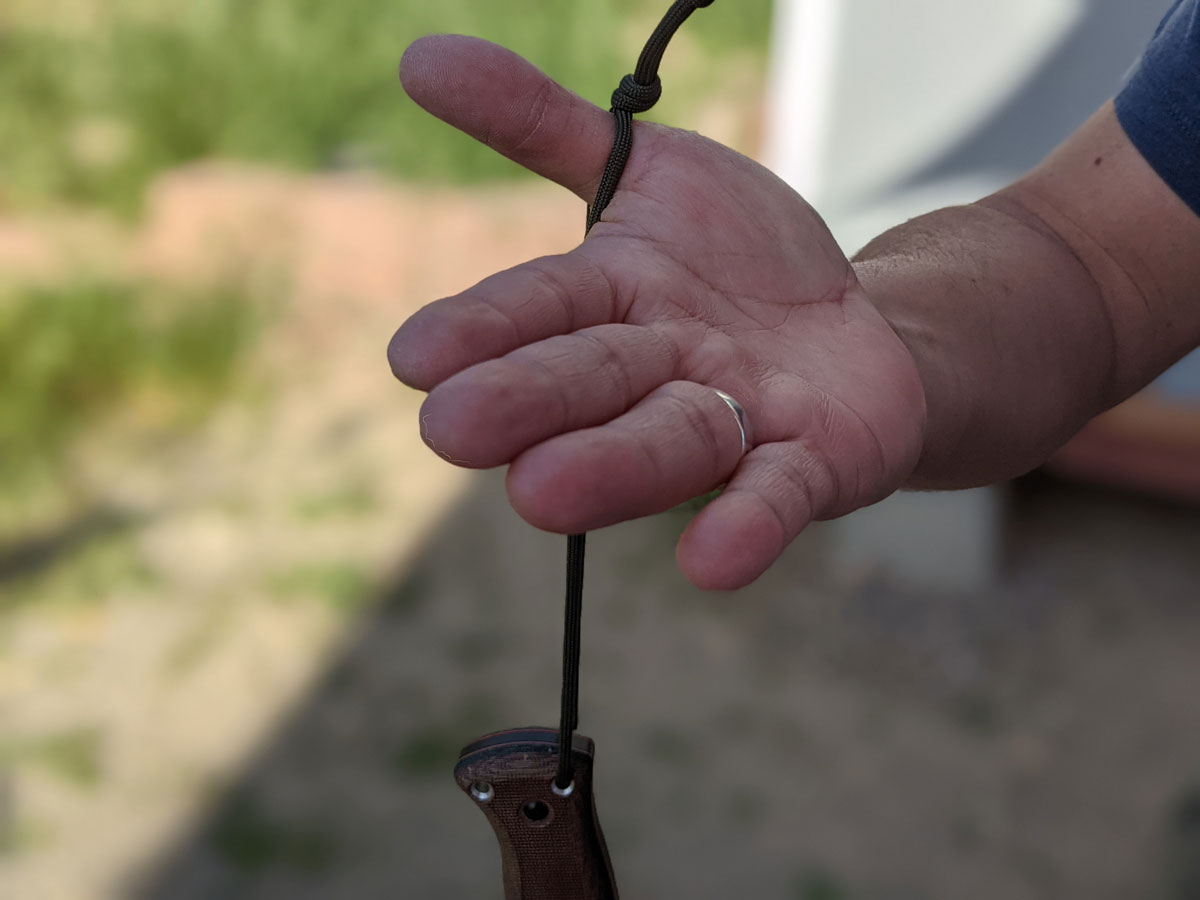
2. Then I turned my wrist so my palm was facing down, causing the lanyard to drape across the back of my hand and the knife blade to hang down toward the ground.
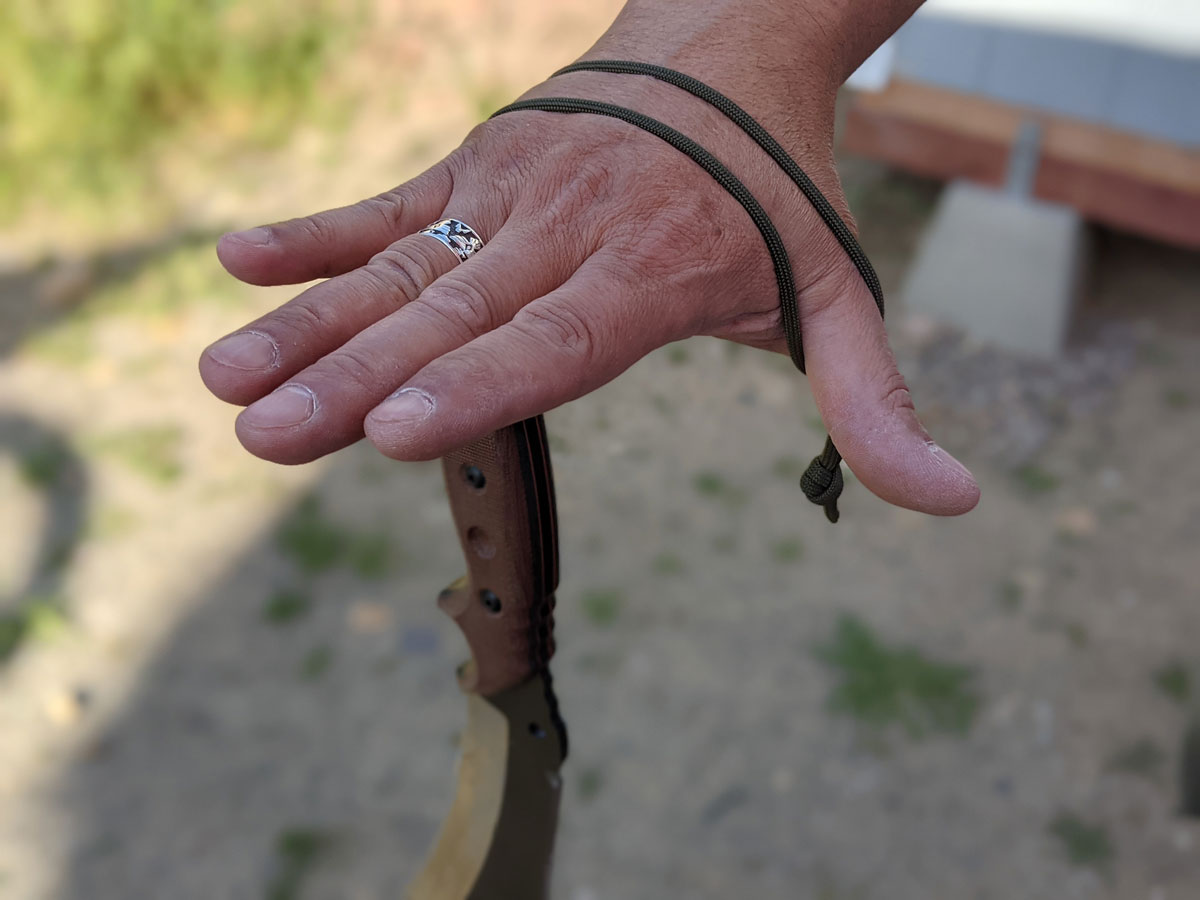
3. At this point, I could grab the knife’s handle, using the lanyard to keep the knife from wiggling around, allowing me to wield the blade safely.
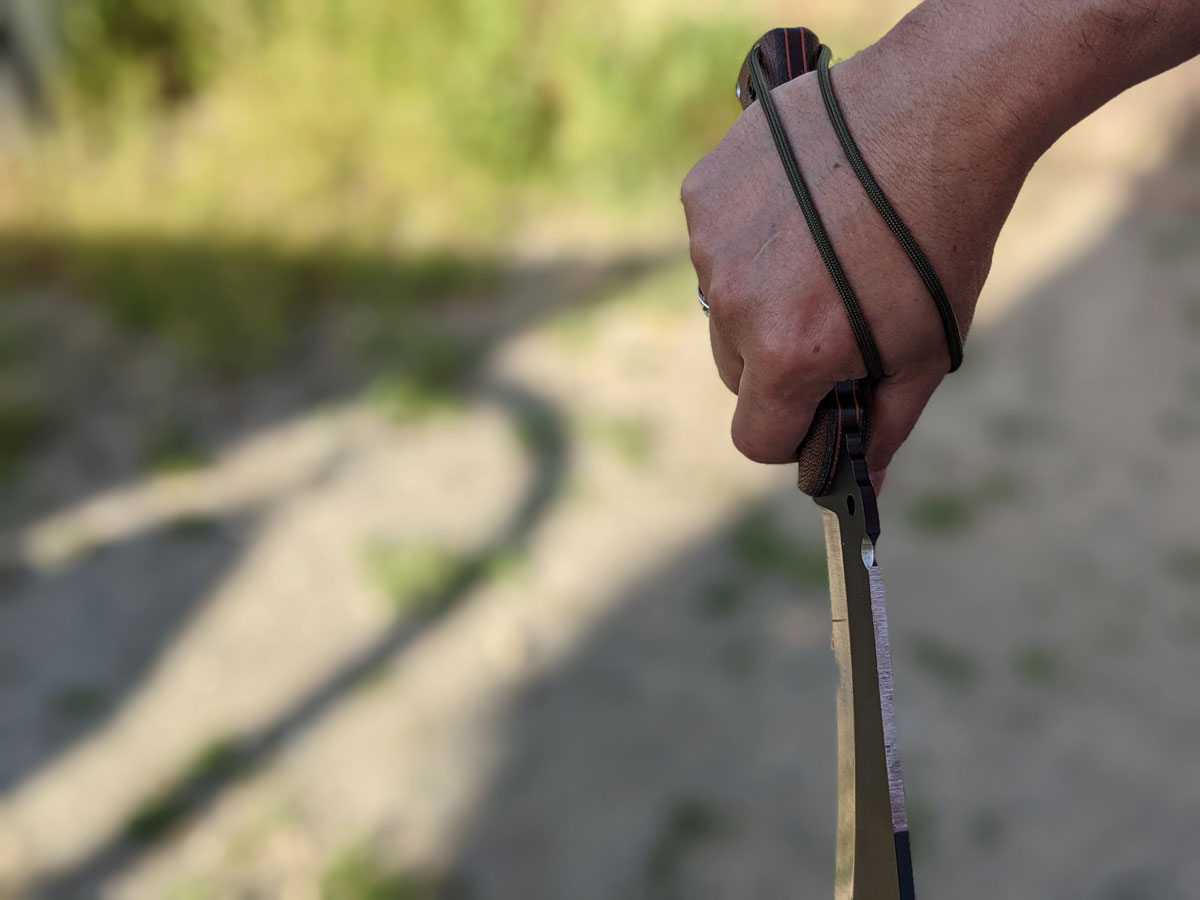
I also used the lanyard to completely change my hold for more detailed tasks that required me to choke up on the blade. In these situations, I simply slid the lanyard loop further up my arm, past my elbow, giving me full range of motion when performing small survival tasks without experiencing any fatigue from holding the blade in place or bearing the weight of the knife.
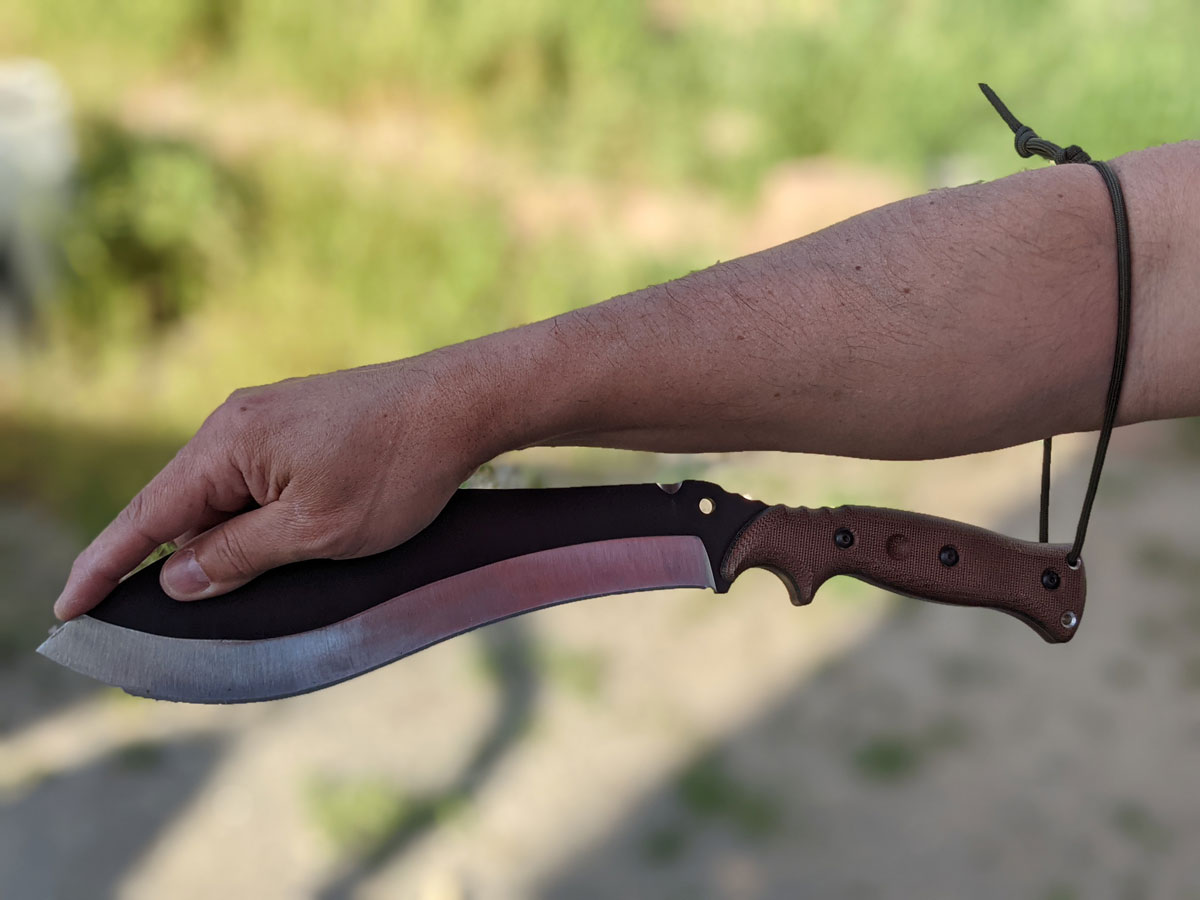
Testing the SLYSTEEL Survival Kukri Knife’s Capabilities by Making a Try Stick
To test how this large knife would hold up performing some smaller survival tasks, I decided to attempt carving some of the finer notches on a try stick, using only the Survival Kukri blade.
What Is a Try Stick?
While knife fanatics are probably already aware of try sticks, not everyone in the various outdoor communities may be familiar with this terminology. A try stick is a carving tool used to practice whittling specific cuts and notches into a piece of wood and helps test out a knife’s capabilities.
Try sticks are also essential tools for bushwhackers and survivalists to know how to make because they can assist in serving various essential functions in the backcountry, like root stripping and trap building.
While try sticks are typically made with small to medium-sized knives, I was determined to see how well the Survival Kukri performed when making a Mors Kochanski try stick.
Mors Kochanski was a Canadian survival instructor best known for his best-selling book, ” Bushcraft: Outdoor Skills and Wilderness Survival.” The Mors Kochanski try stick consists of ten notches and cuts carved into a stick that is traditionally about the length of the carver’s arm when extended and roughly 3 centimeters in diameter. For this test, I only carved five of the essential notches on the try stick.
Crafting the Try Stick
To evaluate the Survival Kukri’s performance, I decided to carve a try stick from a whittled-down piece of firewood. Not surprisingly, the Survival Kukri had absolutely no issue splitting the firewood and made quick work of processing it.
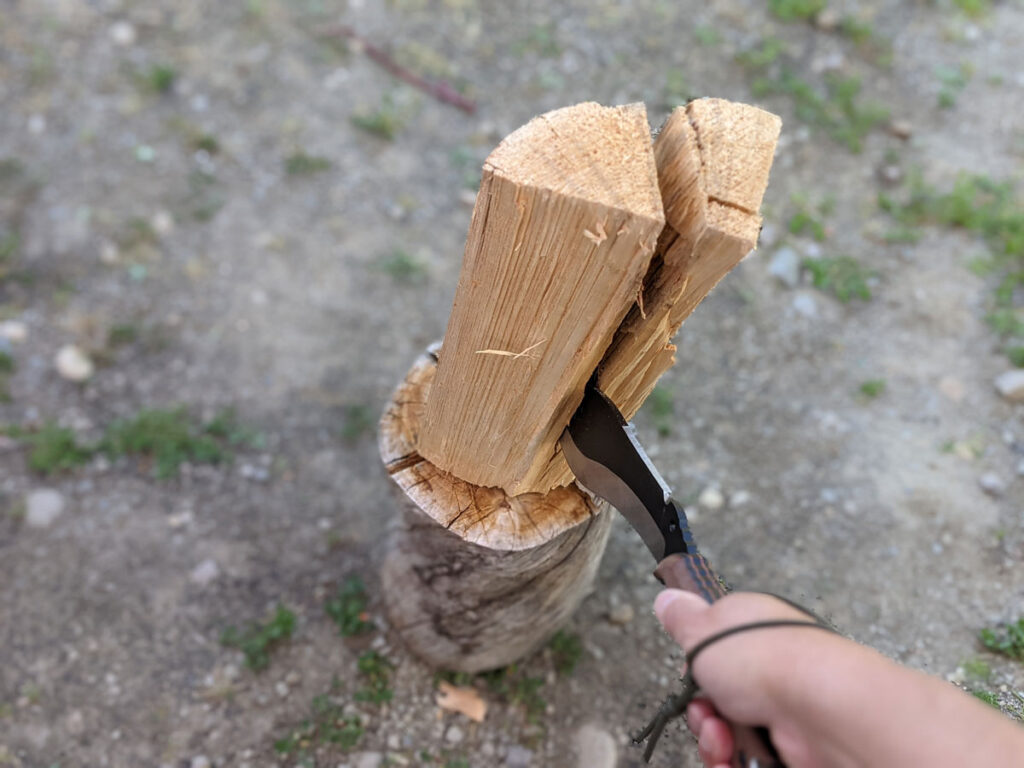
Within a few chops, I was able to split the wood small enough to get a piece that I could then carve into a stick that was roughly 15-inches long and three-quarters of an inch in diameter.
To get the try stick to the correct size, I needed to utilize the vertically-oriented cutting edge on the top part of the Kukri knife. To do so, I buried the knife far enough into the chopping stump to give me a stable working surface and began pulling the wood across the knife, efficiently whittling down my stick.
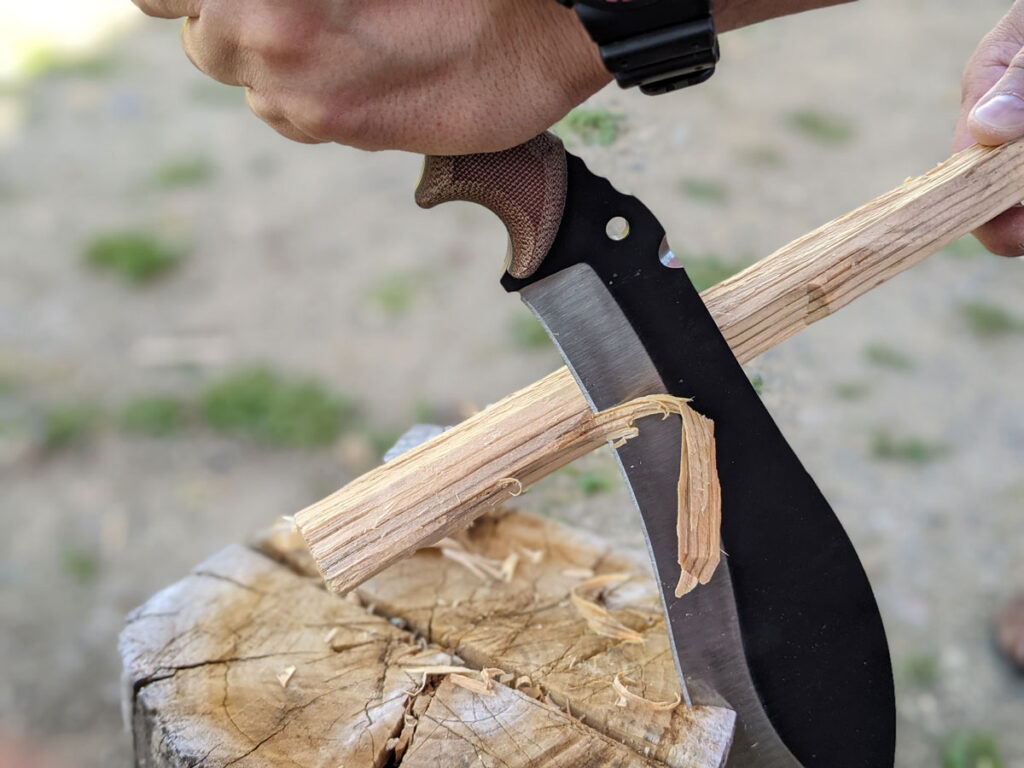
I was so far very pleased with the performance of this blade but was still unsure whether or not the knife would have the ability to create the detailed notches in the try stick I was hoping for.
The first notch I decided to carve was a hook notch, which is a cooking tool used to hang pots over a fire. Try sticks typically have more than one hook notch to adjust the pot height.
I began by very gently batoning an X on one end of the stick. I then performed several push cuts with my thumb while holding the knife’s handle but ultimately opted to switch to the lanyard system so that I could choke up on the blade tip without getting tired.
Because I now had a little more confidence in the Survival Kukri’s performance, I was ready to move forward with attempting some of the more difficult notches on my try stick.
The second notch that I carved required a lot of agility from the blade and consisted of whittling out a hole within a section of the try stick that was reduced on both sides.
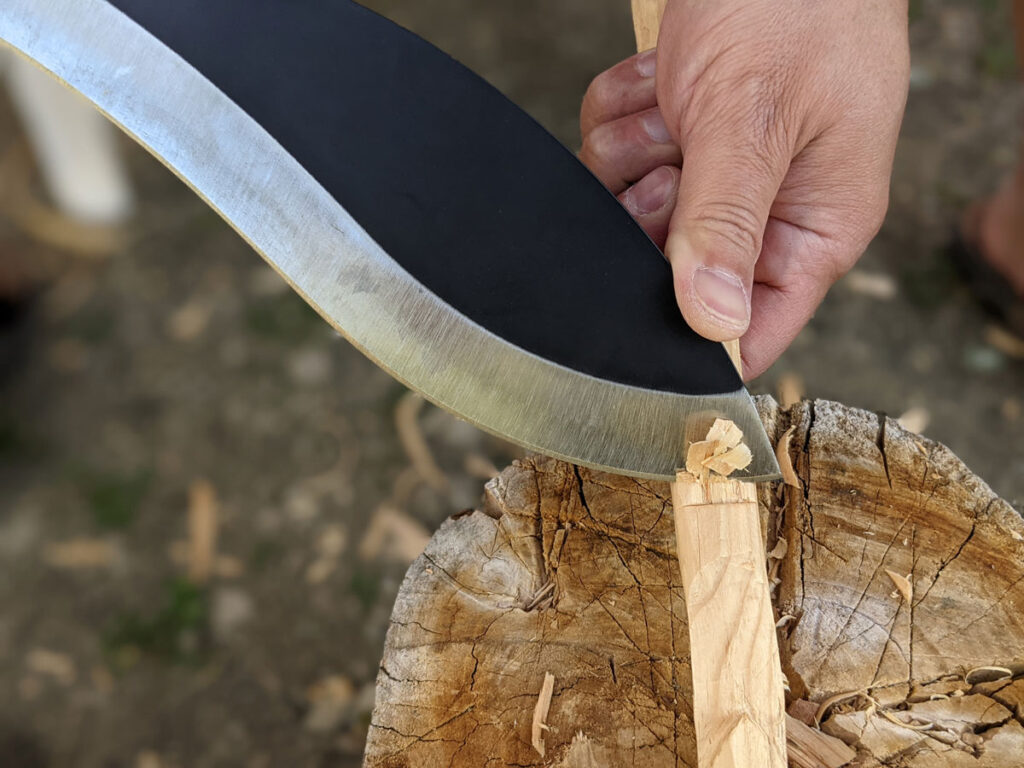
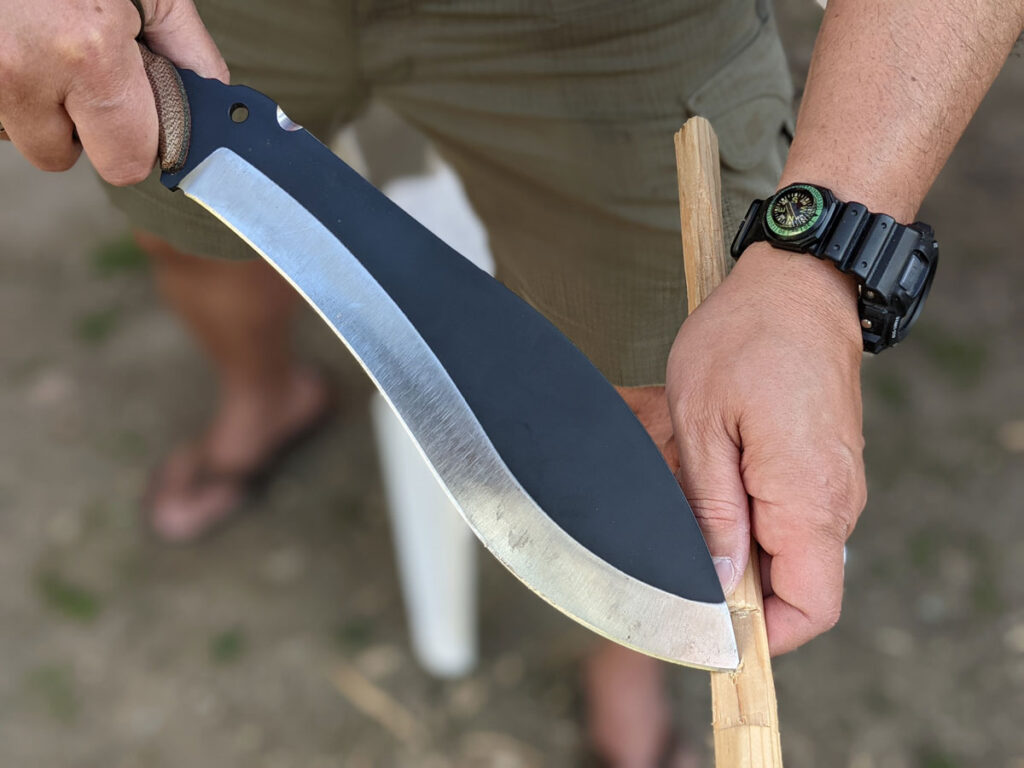
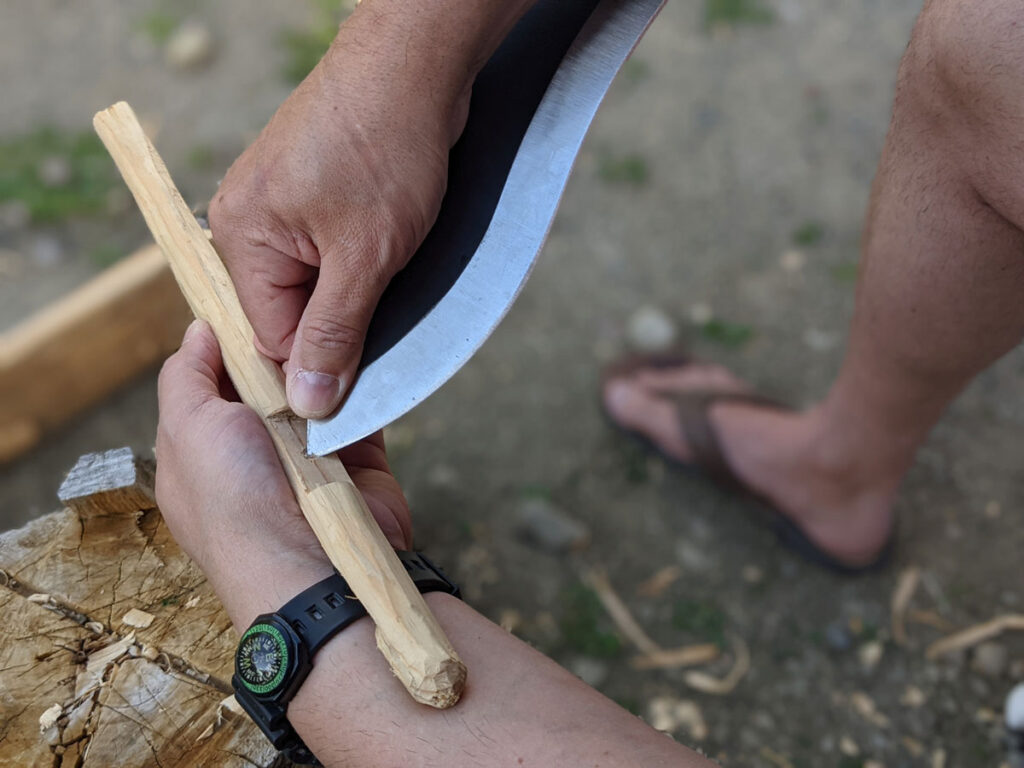
I made the most of the straight alignment between the blade tip and the handle at the beginning of carving the hole but resumed my lanyard hold when I performed the more detailed carving to ensure I was safely wielding the blade.
The next two notches I carved into my try stick were a cylindrical reduction and a beam, which can perform various functions and were intended to see how finely the Survival Kukri could carve in tight spaces.
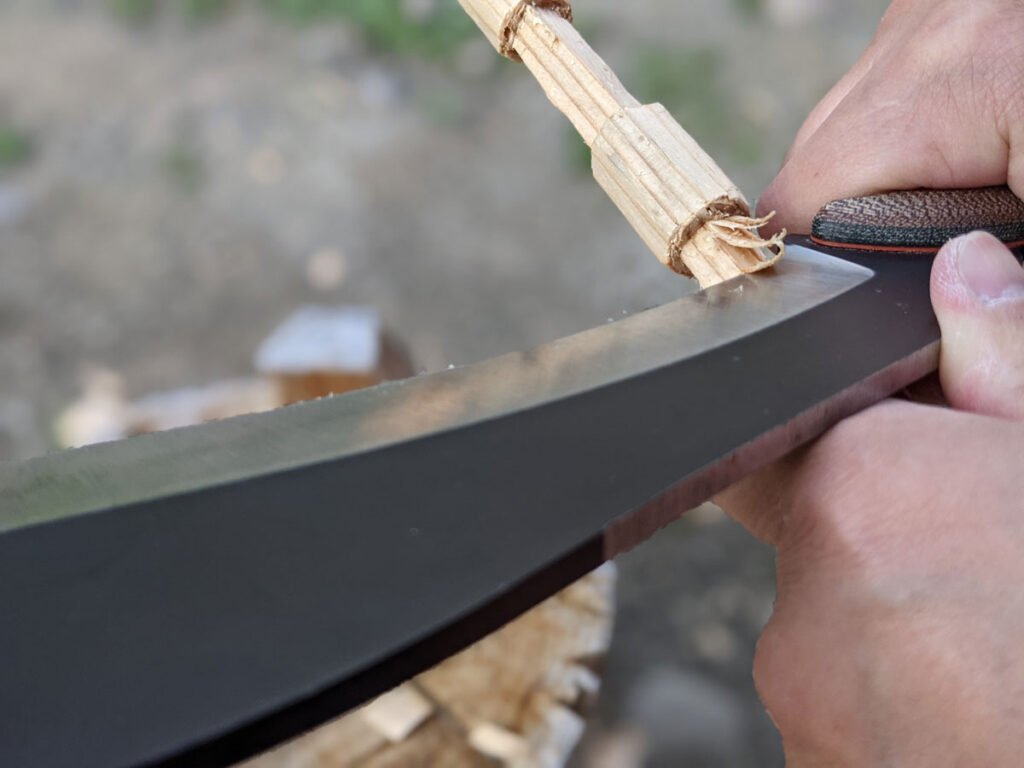
For these notches, I utilized the blade tip and the cutting edge of the knife closest to the handle, which is where the ergonomic handle of the Survival Kukri shined. The handle of this knife has a split-finger grip design that provides comfort when gripping the blade and features a forward finger choil that makes it easy to choke up on the blade when performing intricate tasks.
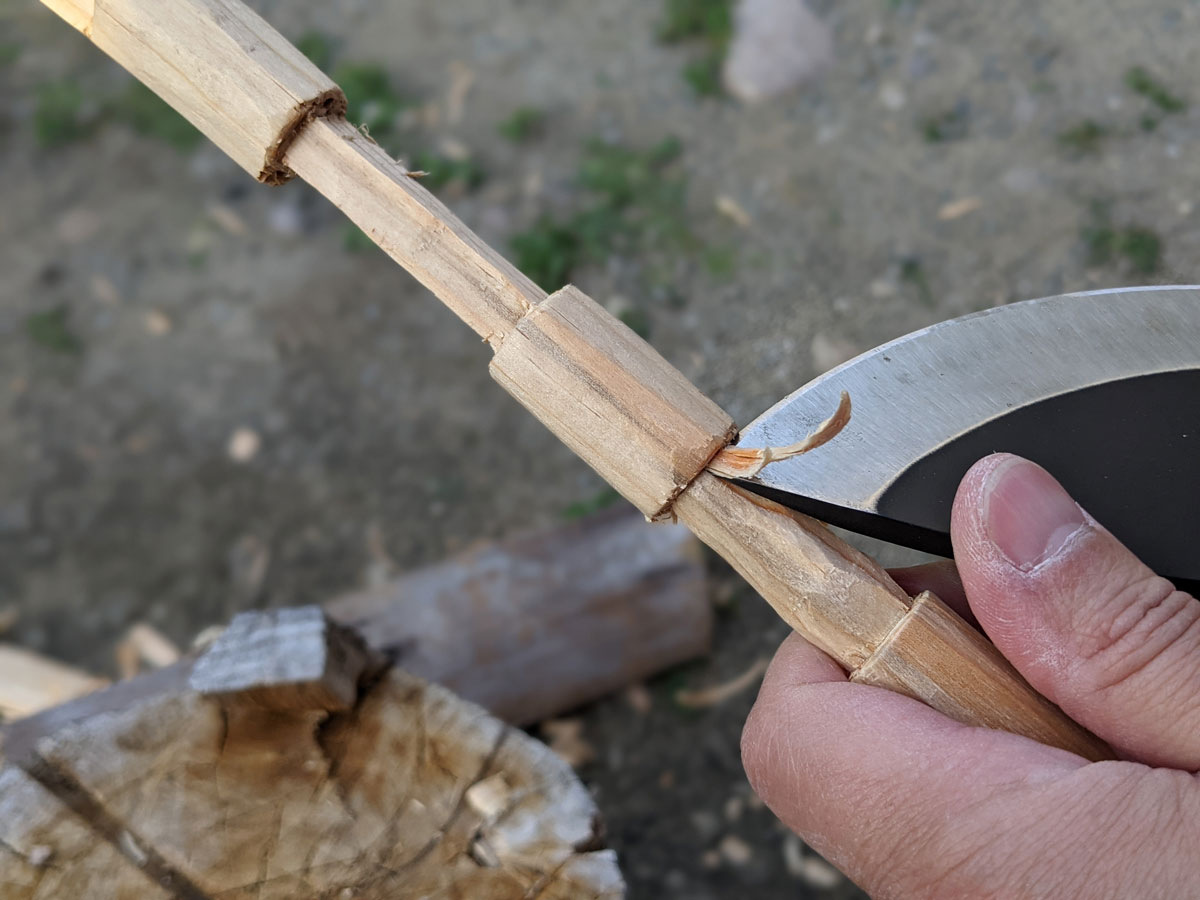
Finally, I carved a root stripper into the end of my try stick, which can be very difficult to accomplish without the right blade. This notch was created by first flattening one of the ends of the try stick and then whittling this end into a pointed prong.
I typically use a small or medium-sized knife to carve wood features such as this, so I was impressed by the Kukri’s ability to create these fine tips without accidentally cutting them off.
How the SLYSTEEL Survival Kukri Knife Performed
Overall, the Survival Kukri performed better than I would have expected for a knife of its size. While it’s no surprise that this large survival knife handled tasks like chopping and batoning wood with ease, it also held its own when performing multiple carving tests designed for much smaller knives.
The Survival Kukri was, in fact, able to carve every notch on my try stick that I attempted, and it didn’t even prove to be that difficult or require a heavy degree of care on my part.
Furthermore, I expected to develop some hotspots while using the knife for these small survival tasks or at the very least experience some mild cramping, but the ergonomic design of the knife actually made the process quite comfortable and provided me with enough control that I felt perfectly safe.
Final Thoughts
As someone who takes survival preparedness very seriously, I understand how important it is to assess the performance of your tools before putting yourself in a situation where your survival depends on them.
When I was serving in the military, I learned a saying that has stuck with me to this day: “two is one, and one is none.” This saying means that being prepared requires you to bring more than one of your essential items. This is because you never know what will happen, and if you lose the only item you brought with you, you’re left to do without it if it gets lost.
For example, what happens if you’re on a canoe trip and you hit unexpected whitewater causing your boat to capsize, resulting in all of your gear floating away? If the only item you have left is the large survival knife you have strapped to your person, can you make do?
While every good survivalist knows that relying on only one cutting tool to perform every task is a fool’s errand, there may come a day when you don’t have a choice. On that day, I might be relieved that the one knife I have in my possession is the SLYTSEEL Survival Kukri, as it can handle much more than just the chopping and splitting for which I brought it.
